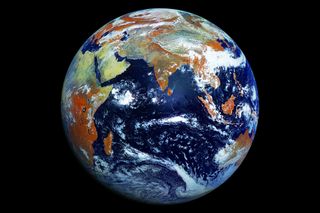
Overshoot Day: Living too Large on a Finite Planet (Op-Ed)

Jon Hoekstra is chief scientist for the World Wildlife Fund (WWF). This article is adapted from one that first appeared on Hoekstra's WWF blog, Science Driven. He contributed this article to LiveScience's Expert Voices: Op-Ed & Insights.
August 20, 2013, marks Earth Overshoot day— the estimated date when the people on Earth have used up the planet's annual supply of renewable natural resources and reached its carbon-absorbing capacity. After that point, people are using more than the planet can sustain. It's a one-day reminder of a year-round problem — humans are living too large on a finite planet.
You probably have a general sense of why. The human population continues to grow. People are consuming more and more resources. And we still have only one planet. To appreciate just how large we are living in relation to our finite planet , let's look more closely at some numbers.
According to the Global Footprint Network, Earth Overshoot day became an issue around 1975. That's when humanity's ecological footprint first exceeded the biocapacity of the planet.
Before that, people's ecological footprint — measured as the area required to supply the food, fish, fiber and energy we consume every year — was within what the planet could sustain. In 1975, there were about 4.1 billion people. Today there are more than 7.3 billion. As the cumulative footprint of the population grows, Earth Overshoot Day moves two to three days earlier each year.
To get a feeling for what humanity's global footprint looks like, consider the land people use to feed themselves. People presently use 38 percent of the planet to grow crops and raise livestock. Many of the agricultural lands are in places that were once temperate grasslands. So much habitat has been turned under by the plow that temperate grasslands are the most imperiled and least protected habitat types on the planet. Future frontiers of agricultural expansion will most likely be in the tropics as people clear high-biodiversity tropical forests to raise cattle, grow soy and install palm oil plantations.
By 2050, the human population is projected to be about 9 billion people. Over that same time, demand for food, water and energy are expected to double. If you think about today's consumption rate per billion people as a shopping cart, people are filling 7 shopping carts. Earth Overshoot Day is a reminder that such a high level of demand is already putting a huge ecological strain on our one planet. By 2050, 9 billion people will be filling twice as many carts per billion — for a total of 18 shopping carts. That's a 150-percent increase in demand!
Sign up for the Live Science daily newsletter now
Get the world’s most fascinating discoveries delivered straight to your inbox.
How can society start to bend the trend to put the planet on a sustainable trajectory?
A first step is to change the mentality about how people grow food and use other natural resources like forests, water and energy resources. Instead of taking more to make more, people need to commit to making more with less. Society also needs to become passionate about efficiency — more crops per drop of water, more miles per gallon of fuel. It's a challenge that should inspire innovation and ingenuity about how people produce and use precious and finite natural resources.
Here is just one of many examples emerging around the world. The Better Cotton Initiative (a partnership that included WWF) worked with cotton farmers to improve management practices on their farms. Over five years, from 2005 to 2010, the results were dramatic — pesticide use was reduced by 60 percent, water use was reduced by 40 percent, synthetic fertilizer use was reduced by 30 percent, and the associated cost savings meant those farmers' incomes increased 15 percent to 20 percent. That's great for farmers, and for the planet, because cotton accounts for 24 percent of the world's insecticide market and 11 percent of global pesticide sales, and 73 percent of the world's cotton crop grows on irrigated land.
You can do your part by taking personal actions to reduce your family's ecological footprint and make sure you're living within your planetary means. To learn more about your footprint and steps you can take, check out the Global Footprint Network's footprint calculator.
Hoekstra's most recent Op-Ed was Conservation 3.0: Protecting Life on a Changing Planet. This article first appeared as "Overshoot Day: Living too Large on a Finite Planet"on Hoekstra's WWF blog, Science Driven. The views expressed are those of the author and do not necessarily reflect the views of the publisher. This article was originally published on Live Science.
Most Popular


